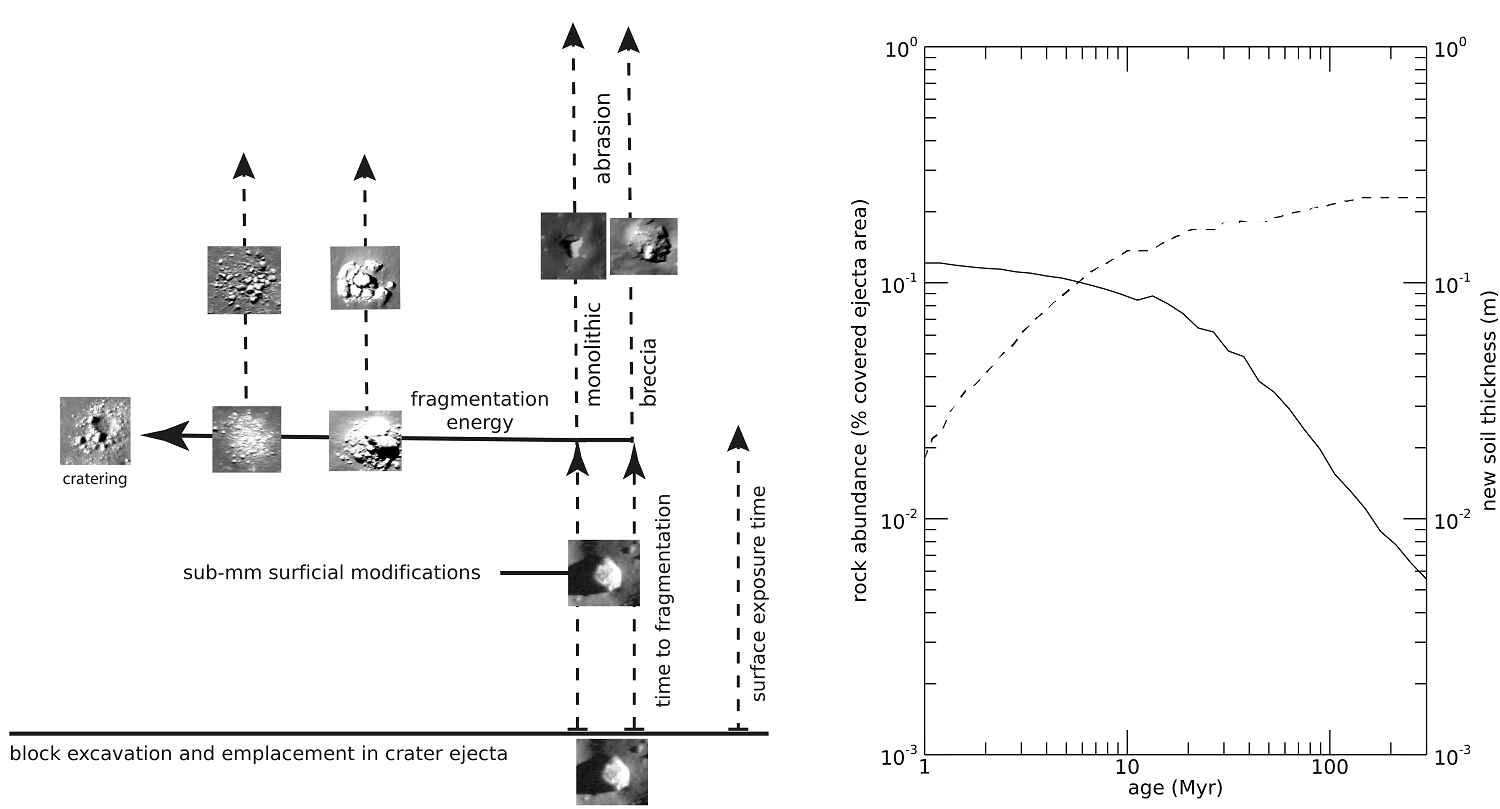Understanding lunar regolith formation through the evolution of boulders
- Institut für Planetologie, Universität Münster, Münster, Germany
We report on the outcomes of several years of study focused on the understanding of the nature and evolution of regolith on airless surfaces, particularly on the Moon, with the unique approach of using lunar rocks as probe of surface processes. Orbital and in situ imaging of the Moon reveal rocks and boulders scattered across the surface. These rocks preserve the chemistry, mineralogy and petrology of the lunar crust and its evolution. Upon exposure to the surface, they are affected by surface processes and thus inform on regolith formation and evolution [e.g., Hörz et al., 2020]. Furthermore, boulders influence processes such as dust lofting and migration, and surface thermal emission. Here we present an overview of our results. We summarize our findings follow the chronological sequence of events during the residence period of rocks on the surface.
We focused our studies on the most frequent context of lunar rocks: the ejecta of impact craters. We studied the photometry of boulder fields around impact craters with modeling and observations and found differences likely associated to the down and up range of the crater impact angle [Marshal et al., 2023]. Variation in petrology has a minor effect on surface microscale roughness and thus on photometry [Marshal et al., 2024], suggesting that the observed difference of boulder fields at lunar craters might be due to the impact-related effect during rock fracturing and excavation. A second unexpected photometric anomaly was found on single instances of ejecta lunar rocks and likely related a soil mantling on top of rocks of peculiar properties [Rüsch et al., 2024a]. These results suggest that the outer surface of lunar rocks is subject to a still unclear set of processes. We found evidence for one of such processes during our laboratory experiment on thermal vacuum cycling on meteorite samples [Patzek et al., 2024]. Upon temperature excursions similar to those experienced on the Moon, we observed formation and detachment of micro-flakes on a lunar meteorite, implying that diurnal temperature variation affect superficially lunar rocks. This could in turn influence the rock photometric response. This phenomenon is likely related to rocks of glass and plagioclase-rich petrologies, such as lunar and impact (melt) breccias [Patzek and Rüsch, 2022]. The newly found micro-flaking, together with micrometeorite abrasion and dust deposition [Rüsch and Wöhler, 2024] occur until rock catastrophic shattering. This shattering event take place once the rock has accumulated sufficient internal damage by repeated meteoroid bombardment. We calculated this lifetime, as a function of the rock size, using meteoroid size-frequency distributions and size-dependent specific shattering functions [Rüsch et al., 2022]. These new lifetime estimates quantitatively describe i) the change in shape of a rock size-frequency distribution with time and ii) the decrease in rock abundance (aerial fraction covered by rocks) around craters with time (Figure 1). The outcomes of rock impact shattering and the produced fragments are clearly visible in orbital imagery around the lunar globe [Rüsch and Bickel, 2023]. We modeled the fate of these fragments produced by impact shattering in order to account for multiple generation of rock fragmentation. This allowed to estimate rock abundances down to the centimeter scale and to estimate the specific shattering energy of lunar boulders. Rock abundances and size-frequency distributions around craters of known radiometric age can be entirely described by modeling shattering by meteoroid bombardment, implying that even if thermal stresses likely modify boulder interior properties, the resulting effect on boulder lifetime is negligible relative to the role of meteoroids bombardment. The current work is threefold: it consists in i) applying the understanding of these processes to an analysis at the quasi-global scale of lunar surface boulders with deep learning algorithms [Aussel et al., 2024], ii) study the underlying processes involving in human image inspection and mapping (including ambiguous rock identification) to underpin, enhance and appropriately use deep learning [Rüsch et al., 2024b], and iii) understand the effect of impact (shock and impact melt) on the microscale roughness of rock samples.
Figure 1. The evolution of lunar boulders. (left) Instances of boulders in crater ejecta at different evolutionary stages, from Rüsch and Bickel (2023). (right) Modeled decrease of rock abundance in a crater ejecta for all rocks above 1 m (solid line) and corresponding formation of new regolith soil (particles <1 cm) (dashed line), using the model of Rüsch et al. (2022). Ejecta radius is 1.5 crater radius. Crater radius is 0.5 km.

How to cite: Rüsch, O., Marshal, R. M., Patzek, M., and Aussel, B.: Understanding lunar regolith formation through the evolution of boulders, Europlanet Science Congress 2024, Berlin, Germany, 8–13 Sep 2024, EPSC2024-717, https://doi.org/10.5194/epsc2024-717, 2024.